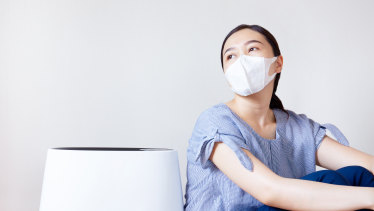Air purifiers are the big trend for 2020, but are they worth it?
With air pollution worsening around the world, and estimates that indoor air pollution can be up to five times higher indoors, air purifiers are emerging as a big wellness trend for 2020.
According to MarketWatch, global demand for the products is growing at a rate of nearly 10 per cent a year with the global market expected to reach $33 billion by 2023.
Air purifiers manage the problem, but don’t treat it and they cannot remove all pollutants.Credit:Getty
As distinct from air conditioners, which regulate the air temperature but do not necessarily filter the air, purifiers are designed to capture pollutants and particles while pushing clean, filtered air back out into single rooms.
Priced between roughly $100 and $2000 – with some even pitching themselves as the best for bushfire smoke – the question is: are air purifiers worth it?
Adele Taylor, manager of the Sensitive Choice product assessment program at the National Asthma Council Australia, said there was "debate around the effectiveness of air purifiers”.
Sensitive Choice has reviewed a "large number" of air purifiers and Ms Taylor says certain features may be better equipped to help those with asthma or allergies.
Those include a high-efficiency particulate air (HEPA) 13-grade or higher filter (which can remove PM 2.5-sized particles) and an activated carbon filter, which can help to remove smoke and gasses from the air.
"An air purifier has the potential to help with bushfire smoke and pollution by using multistage filtration system to remove a variety of pollutants from the air, however, factors such as the size of the machine compared with the size of the room, whether you have pets and where you live all impact the effectiveness of the machine," Ms Taylor said.
Professor Bruce Thompson, respiratory expert and dean of the School of Health Sciences at Swinburne University, agrees that despite a market trend towards smaller devices, size does matter and people should select an air purifier that matches the size of their room.
"If you've got a whole airconditioning system that’s closed and fully filtered with a HEPA-type filter that filters out anything that’s less than 2.5 microns [it might be effective]," he said.
"But having a potential air purifier sitting in the corner of your room, it really depends on the size of the air purifier. It’s unlikely for it to do a whole lot."
While bushfires continue to bring hazardous air conditions, masks are another option.
"But it has to be the P2 mask that filters out the PM 2.5 and the important thing is it needs to be fitted properly," Professor Thompson said. "If you just wear a standard mask, it's not going to do anything in terms of the really hazardous pollutants."
Those with respiratory disease can safeguard themselves by ensuring they take their medication, something up to 70 per cent of asthmatics are not doing, as well as by removing or reducing other sources of indoor air pollution in their home, notably dust mites, harsh cleaning chemicals, cigarette smoke, non-flued gas heaters, wood-burning fires and personal care products like hairspray.
Professor Thompson said while there was "some data" to suggest purifiers could help to alleviate allergies by removing allergens from the air, these trials were done on "whopping big" devices.
Instead of purchasing a product that may or may not be effective, Professor Thompson says the "best thing" to do is stay as far from bushfire smoke and air pollution as we can "in an environment that has filtered air".
"Maybe go and see a movie and get yourself some relief."
He adds a need to keep the pressure on our government to act on climate: "We made huge progress in protecting our waterways and cleaning them up from pollution … why are we ignoring the atmosphere we breathe?"
Source: Read Full Article



